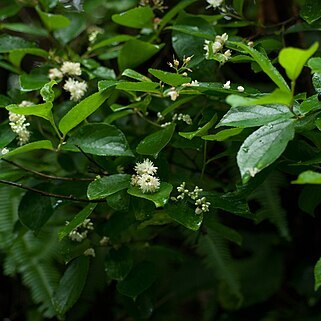Shrubs or small trees, deciduous. Young branchlets glabrous or ± pilose; old branchlets glabrous. Petiole 3--7 mm; leaf blade ovate, elliptic-obovate, or broadly obovate, usually slightly rhomboid, 1.5--11 X 1--5.5 cm, membranous to thinly papery, abaxially glabrous or pubescent, adaxially glabrous or appressed hairy, base broadly cuneate to subcordate, margin sharply glandular dentate, apex acuminate to acute, lateral veins 4--10 pairs. Panicles terminal, consisting of a raceme of cymose corymbs, 2--10 cm; bracts early deciduous, usually linear, ca. 1(--3) mm, brown glandular. Pedicel 0--10 mm, slender, thickening in fruit, articulate at apex. Ovary obconic, 1--1.5 mm, glabrous or hairy, 2-locular, with 4 ovules per locule. Calyx lobes light yellow, ovate to semi-orbicular, 1--1.5 mm, sometimes abaxially hairy, margin ciliate. Corolla 3--6 mm. Stamens 25--60. Disc 5-glandular, glabrous or hairy. Drupes bluish, rarely white, ovate-globose, 3--8 mm. Fl. Apr-Jun, fr. Sep-Nov.
A shrub which loses its leaves. It grows 4.5 m high and spreads 4.5 m wide. The leaves are oval and slightly hairy. The leaves are small and have very fine teeth. The flowers are white and have a scent. They occur in clusters. The fruit are round blue berries.

